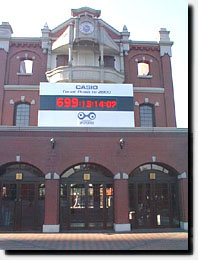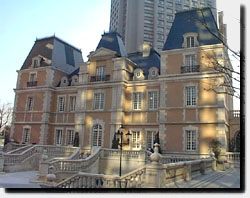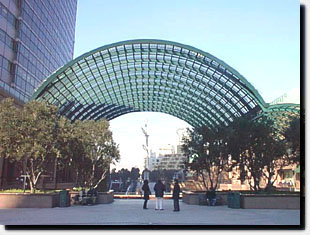Ebisu Garden Place is the newest and the most luxury example of urban redevelopment. This land was earlier used by a brewery named "Ebisu Beer".
Ebisu, God of fortune and the name of this area in fact came from that beer brewery. The company could not survive the competition and "Ebisu Beer" disappeared long time ago. However, this premise went under the ownership of another brewery and now "Ebisu Beer" labels are again on the market.
The new owner of the premise wanted to have a comprehensive "office - residence - amenity" complex. After long preparation and construction, when the complex was completed, the bubble economy was already gone. Nevertheless, as the premise is big and its location is good, the luxury investment was rewarded.
I was abroad when I heard about the opening and good business of Ebisu Garden Place, and became curious about it. Therefore, I came here immediately after my return to Japan.
This is a good example of neat and tidy places which appear these days one after another. No stain shall remain either on the floor or on the wall. Also, compared with older buildings Ebisu Garden Place is distinctively more gorgeous and luxury. You can see this immediately when you come out of the shelter of a long, long air bridge from Ebisu JR station. This might be the style of our time.
Going down a wide slope with flowing water on a side you can reach the main square, where there are several Christmas trees as it will be soon December. On the ground floor there are many beer halls in the old brewery like surroundings. There are also many other restaurants and coffee shops. You can find one of the most exquisite department stores here as well. And at the end of the main square you can easily find a building exactly like a castle in Loire. This is a classy French restaurant.

Count down for the year 2000.
Is 2000 the 21th century ?

Taillevent Japan
As I told already, everything is tidy and clean and by no means cheap made. This place is really appreciated by many people, men and women, young and old. However, I feel somewhat uneasy. Main part of what I see here is a sort of imitation of European architecture. It is sure that imitation is carefully done and attention is paid to every detail. But, I cannot help feeling that this is like
imitation gold.
Maybe after 1000 years tourists can enjoy colossal ruins on Japanese islands, like we now enjoy Roman imitation of Greek architecture. Or, is this a too optimistic analysis?


